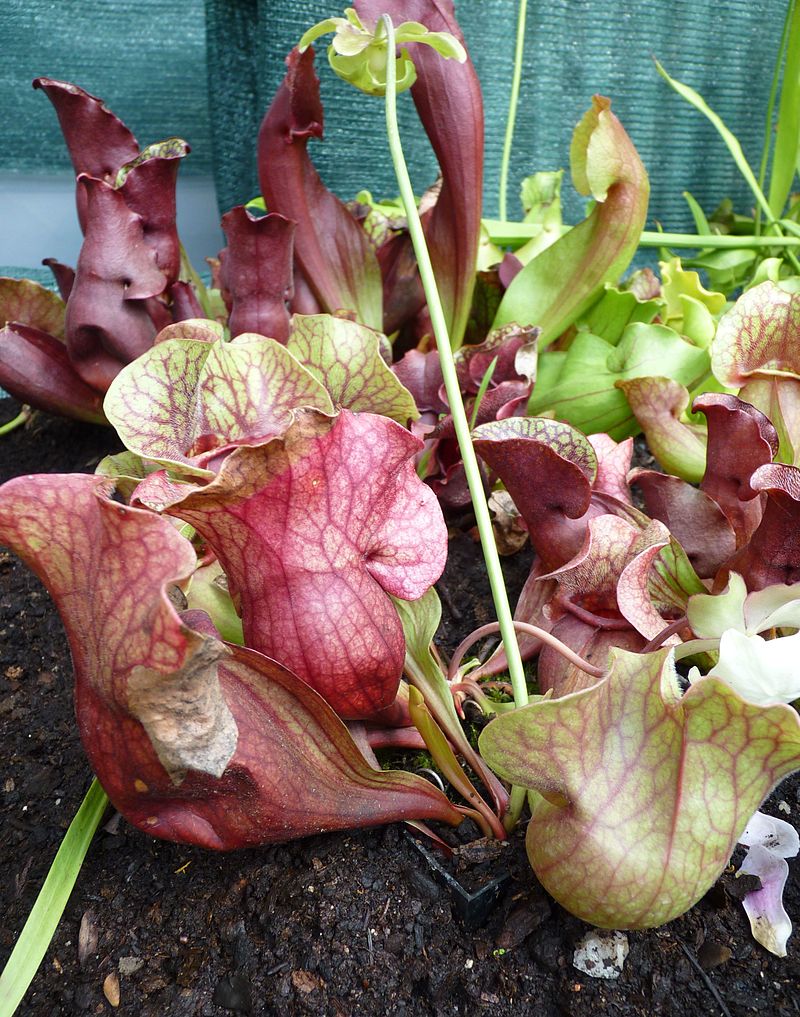| Kingdom: | Plantae |
| Phylum: | Tracheophyta |
| Class: | Magnoliopsida |
| Order: | Ericales |
| Family: | Sarraceniaceae |
| Genus: | Sarracenia |
| Species: | purpurea |
Morphology and Prey Attraction:
The purple pitcher plant, Sarracenia pupurea L., is part of the Sarraceniaceae family (full description). It uses enzymes to breakdown and digest any prey that happen to find themselves inside one of these deadly pitchers. But first, the plant has to put some effort in before it can capture anything. Generally speaking, the larger the pitcher, the more and larger prey it is able to capture. In addition, the larger the pitcher the more difficult it is to escape the pitcher (Cresswell, 1993). The pitchers also need to be appealing both by smell and sight! With more and brighter stripes on the leaf (red venation in figure 1) and a larger volume of nectar, the trap will be more irresistible for prey to pass up. One of the reasons for attraction may be due to the presence of a chemical called sarracenin inside the plants leaves, flower buds, and root system (Newman et al. 1999). In pitchers of the Heliamphor genus (same family as saracennia), sarracenin is found inside the nectar of the plant (Plachno et al. 2007). Taking into account the wide distribution of sarracenin throughout S. purpurea and the presence of it in the nectar of genus in the same family, it is seems likely that the increased attractiveness of the nectar would be due to the presence of this secondary metabolite. Sarracenin is a monoterpene and is volatile which makes attracting prey a little too easy for this killer. Having insects drawn in by the smell of nectar makes the visual attraction of your leaves be seen by as many insects as possible, thus increasing the chance of getting to consume prey, it almost seems unfair.

Figure 1: A pitcher filled with digestive liquid (Note red venation) – PitcherPlanter765567 on wikimedia

Figure 2: Serracenin — enol diacetal monoterpene
Prey Consumption
The prey drawn into these plants find only a digestive liquid that breaks them down slowly for the plant to absorb (Stewart, 2009). Once inside, getting out becomes a seemingly unachievable task for the insects. Protease, RNase, nuclease, and phosphatase have been found inside of the digestive fluids (Gallie, 1997). However, only a few drops enzymes are produced by the plant and the rest is rain water (When the trap senses nutrients inside of its pitcher, it releases these enzymes into its pitcher’s fluid. Since this is an induced response, it is relatively biologically cheap in comparison to if it was constitutively induced. The ecological importance of a plant-prey interaction in the peat bogs, where this plant is found, is significant in that it creates an link that do not exist in most nitrogen and phosphorus cycles by allowing the plant to do the consumption of the insect and not the other way around. This is important because of the characteristic lack of phosphorus and fixed nitrogen found within the soils of bogs (learn more about bogs).
Redeeming Qualities
As well as being a death trap for unwary insect, there are multiple cultural uses for this plant. Native Americans tribes, for example, used S. purpurea to make a tea that aids in ease of birthing (Smith, 1932). Also, the Cree of Eyou Istchee in northern Quèbec used this plant to make traditional medicine to treat their diabetic symptoms (Harris et al. 2012). In an attempt to investigate the ability of the plant’s root and leaf extracts to treat these diabetic symptoms, researchers tested the extracts on an in vitro model of diabetic neuropathy. They found that the extracts were able to inhibit the glucose-mediated death of the cells of the model, which was made possible by the hyperoside and glucoside identified in the extracts. Even though S. purpurea appears to be bringer of death, it still has the capability to nurture health.

Figure 3: Hyperoside

Figure 4: Morroniside
References
Cresswell, E. James. 1993. “The morphological correlates of the prey capture and resource parasitism in pitchers of the carnivorous plant Sarracenia purpurea.” The American Midland Naturalist 129(1): 35-41.
Gallie D., Chang S.C. 1997. “Signal transduction in the carnivorous plant Sarracenia purpurea (regulation of secretory hydrolase expression during development and in response to resources).” Amer. Society of Plant Biologists 115(4): 1461-1471.
Harris C, Asim M, Saleem A, Haddad P, Arnason J, and Beennett S. 2012. “Characterizing the cytoprotective activity of Sarracenia purpurea L., a medicinal plant that inhibits glucotoxicity in P12 cells.” BMC Complment. And Alt. Med. 12:245.
Leduc, C. 2006. “Plants used by the Cree Nation of Eeyou Istchee (Quebec, Canada) for the treatment of diabetes: a novel approach in quantitative ethnobotany.” Journal of Ethnopharm. 105(1-2): 55-63.
Stewart, Amy. 2009. “Wicked plants: the weed that killed lincoln’s mother and other botanical atrocities.” Chapel Hill (NC): Algonquin Books of Chapel Hill.
Smith, Huron. 1932. “Enthnobotany of the ojibwe Indians.” Milwaukee (WI): Public Museum of the City of Milwaukee.

